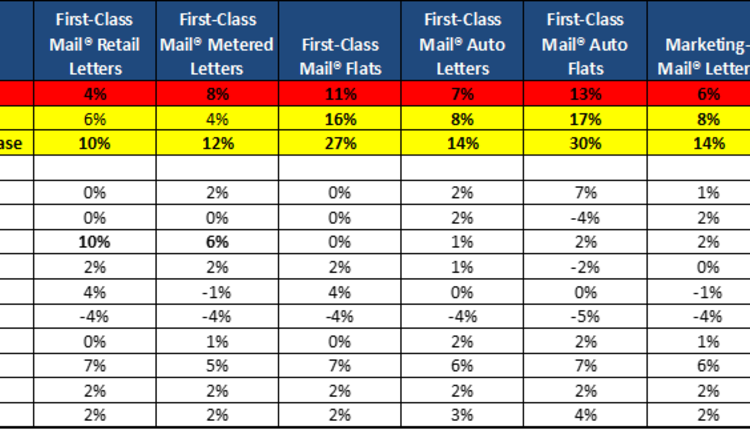I have been doing my best to stay on top of all of the news, articles and updates around the proposed USPS changes. It is clear that they need to take action, but many of the proposals are going to hurt them in the long run, and could lead to much faster transitions to electronic replacement. First-Class Mail, which is seeing the steepest declines (down approximately 25% in the last 5 years), is the main profit driver for the Post Office represents 45% of the piece volume but 57% of the revenue. Even with the slight growth rates in Package Services and Standard Mail, they cannot offset declining First-Class Mail.
Here is how the proposed changes will force mailers to replace First-Class Mail for faster electronic alternatives, thereby negatively affecting the Post Office and its bottom line.
Slower Delivery Standards The Post Office is proposing closing over half of their sectional center facilities. The thought is that by changing the entrance times and utilizing their equipment for the majority vs. minority of the day, they will be able to run with fewer facilities. To make this feasible, they are proposing eliminating the next day delivery objectives for local mail and moving to a two day plus model. This gives them more flexibility with entrance times and cut offs.
Businesses are the main volume driver of First-Class Mail. It is our bills, statements, checks and anything that can be deemed â¬Å"Personal in Correspondenceâ¬â requiring this premium mail service. Presort Mail (all from businesses) makes up 63% of all First-Class and a good percentage of the remaining 37% is from these same businesses as single piece. When it takes more time to get these pieces delivered, mailers will look for faster options, which will lead them to digital. When 1-3 days leads to 2-4 it is also going to force them to consider other options - to fix cash flow and customer service issues that are inevitably going to arise. Also, with this massive shrinkage in facilities, peak mailing times could face further delays as the capacity may not be available. For example, in January with tax information, quarter end statements and holiday peaks could create pressures on a much smaller production network. Especially since the closures will be happening over a relatively short time period.
Closing 4000 Facilities! This is 3,700 Post Office locations and 300 Sectional Center Facilities. This means businesses and consumers may have to travel farther to deposit their mail. This creates extra costs for mailers and will again force people to think more about the speed, simplicity and convenience of electronic delivery.
Eliminating Saturday Delivery This is going to hurt two main parts of business:
1. Businesses Sending Invoices When you combine the delayed delivery of mail with the elimination of Saturday Delivery, business could see 2-3 days in additional time to get invoices delivered and paid. This is not as much of an issue when sending invoices to businesses because they typically have systems in place to pay by the due date. The problem comes with consumers who pay bills at set times based on their convenience/schedules. If the bill comes in later, it will get paid later. Also, many people pay their bills on weekends when they have more time. If the bill is already delayed a day because of the new delivery standards and now without Saturday, that piece will not be delivered until Monday. Businesses will push harder for customer to agree to electronic invoices so they can get the bills delivered faster and to be able to get paid quicker.
2. Businesses Sending Solicitations Customers shop on weekends! No one can question that if you have ever gone to your local mall. Special offers are designed to get customers to shop when they have time which is why so many special offers come in on Friday and Saturdays. Eliminating Saturday delivery will make it more difficult to reach customers when they want to buy forcing business to look at other advertising mediums outside of mail (Social Media, Groupon, Email, Etc) where they can reach customers on their desired weekend days.
Solution: I am proposing that we look to solve many of the Postal issues by having rates comparable to the rest of the world. No one would ever complain about having a letter sent from Boston to Hawaii for $.44. Some comedians have even made jokes about this concept. We have the lowest postal rates of the developed countries, yet with the upcoming rates, they are only proposing a 2% Increase. UPS and FedEx increase rates 5-6% per year in January and no one blinks an eye. Can you imagine if FedEx came out and said that it was slowing its delivery of all of its packages to reduce costs?
They get around this by streamlining their networks at the same service levels and increasing our costs.
I do agree that the Post Office should look at cutting costs and some service standards. Facilities do need to be changed/eliminated. The issue is the massive amount of change in a short period of time will create visibility to mail. Whenever this happens, customers will be looking for solutions to minimize the impact. Digital migration will become more attractive and implemented faster. Businesses will start looking at different tactics to get their customers to agree to accept electronic communications like offering incentives or charging premiums to get hard copy.
We have the greatest postal system in the world and maintaining that system is incredibly important to the US Economy. The worry is that decreasing service will hurt long term sustainability more than help.
Adam Lewenberg, CMDSS is President of Postal Advocate Inc. with over 18 years of experience in the mail industry. Their mission is to help companies reduce mail related expense and streamline operations. He can be reached at (617)372-8653 or adam.lewenberg@postaladvocate.com.
Here is how the proposed changes will force mailers to replace First-Class Mail for faster electronic alternatives, thereby negatively affecting the Post Office and its bottom line.
Slower Delivery Standards The Post Office is proposing closing over half of their sectional center facilities. The thought is that by changing the entrance times and utilizing their equipment for the majority vs. minority of the day, they will be able to run with fewer facilities. To make this feasible, they are proposing eliminating the next day delivery objectives for local mail and moving to a two day plus model. This gives them more flexibility with entrance times and cut offs.
Businesses are the main volume driver of First-Class Mail. It is our bills, statements, checks and anything that can be deemed â¬Å"Personal in Correspondenceâ¬â requiring this premium mail service. Presort Mail (all from businesses) makes up 63% of all First-Class and a good percentage of the remaining 37% is from these same businesses as single piece. When it takes more time to get these pieces delivered, mailers will look for faster options, which will lead them to digital. When 1-3 days leads to 2-4 it is also going to force them to consider other options - to fix cash flow and customer service issues that are inevitably going to arise. Also, with this massive shrinkage in facilities, peak mailing times could face further delays as the capacity may not be available. For example, in January with tax information, quarter end statements and holiday peaks could create pressures on a much smaller production network. Especially since the closures will be happening over a relatively short time period.
Closing 4000 Facilities! This is 3,700 Post Office locations and 300 Sectional Center Facilities. This means businesses and consumers may have to travel farther to deposit their mail. This creates extra costs for mailers and will again force people to think more about the speed, simplicity and convenience of electronic delivery.
Eliminating Saturday Delivery This is going to hurt two main parts of business:
1. Businesses Sending Invoices When you combine the delayed delivery of mail with the elimination of Saturday Delivery, business could see 2-3 days in additional time to get invoices delivered and paid. This is not as much of an issue when sending invoices to businesses because they typically have systems in place to pay by the due date. The problem comes with consumers who pay bills at set times based on their convenience/schedules. If the bill comes in later, it will get paid later. Also, many people pay their bills on weekends when they have more time. If the bill is already delayed a day because of the new delivery standards and now without Saturday, that piece will not be delivered until Monday. Businesses will push harder for customer to agree to electronic invoices so they can get the bills delivered faster and to be able to get paid quicker.
2. Businesses Sending Solicitations Customers shop on weekends! No one can question that if you have ever gone to your local mall. Special offers are designed to get customers to shop when they have time which is why so many special offers come in on Friday and Saturdays. Eliminating Saturday delivery will make it more difficult to reach customers when they want to buy forcing business to look at other advertising mediums outside of mail (Social Media, Groupon, Email, Etc) where they can reach customers on their desired weekend days.
Solution: I am proposing that we look to solve many of the Postal issues by having rates comparable to the rest of the world. No one would ever complain about having a letter sent from Boston to Hawaii for $.44. Some comedians have even made jokes about this concept. We have the lowest postal rates of the developed countries, yet with the upcoming rates, they are only proposing a 2% Increase. UPS and FedEx increase rates 5-6% per year in January and no one blinks an eye. Can you imagine if FedEx came out and said that it was slowing its delivery of all of its packages to reduce costs?
They get around this by streamlining their networks at the same service levels and increasing our costs.
I do agree that the Post Office should look at cutting costs and some service standards. Facilities do need to be changed/eliminated. The issue is the massive amount of change in a short period of time will create visibility to mail. Whenever this happens, customers will be looking for solutions to minimize the impact. Digital migration will become more attractive and implemented faster. Businesses will start looking at different tactics to get their customers to agree to accept electronic communications like offering incentives or charging premiums to get hard copy.
We have the greatest postal system in the world and maintaining that system is incredibly important to the US Economy. The worry is that decreasing service will hurt long term sustainability more than help.
Adam Lewenberg, CMDSS is President of Postal Advocate Inc. with over 18 years of experience in the mail industry. Their mission is to help companies reduce mail related expense and streamline operations. He can be reached at (617)372-8653 or adam.lewenberg@postaladvocate.com.






![GettyImages-1170541989-[Converted]](https://cms-static.wehaacdn.com/mailingsystemstechnology-com/images/GettyImages-1170541989--Converted-.1803.widea.0.jpg)



